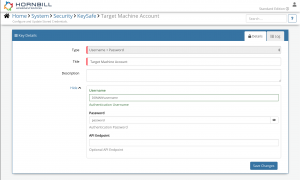Difference between revisions of "Service Management (systemd)"
(→Reload) |
|||
| Line 1: | Line 1: | ||
| − | {{bluebanner|[[Main_Page|Home]] > [[Administration]] > [[IT_Operations_Management|IT Operations Management]] > [[ITOM_Package_Library|ITOM Package Library]] > | + | {{bluebanner|[[Main_Page|Home]] > [[Administration]] > [[IT_Operations_Management|IT Operations Management]] > [[ITOM_Package_Library|ITOM Package Library]] > Service Management (systemd) |[[:Category:ITOM|Index]]}} |
[[File:Tux.svg.png|300px]] | [[File:Tux.svg.png|300px]] | ||
{{IntroAndLinks|Provides operations to control and manage the state of services using the "systemd" tool; systemctl. | {{IntroAndLinks|Provides operations to control and manage the state of services using the "systemd" tool; systemctl. | ||
| Line 39: | Line 39: | ||
==Package Operations== | ==Package Operations== | ||
| − | The | + | The Service Management (systemd) package contains the following operations, than can be used to create ITOM Jobs directly, or included in your [[Business_Process_Designer|Business Processes]] and/or IT Operations Management Runbooks. |
Revision as of 11:07, 9 September 2021
| Home > Administration > IT Operations Management > ITOM Package Library > Service Management (systemd) | Index |
IntroductionProvides operations to control and manage the state of services using the "systemd" tool; systemctl.
|
|
Target Environment Requirements
Credentials
Except for the Is Package Installed operation, Accounts used when executing jobs against operations contained within this package must adhere to the following requirements:
- The target machine must have a local admin user that will be used for running the operations;
- SSH Remote Login must be enabled for the user above user
- Configuration for the user must be added to the sudoers file on the target machine, to allow the above user to sudo without a password (example: __someadminuser ALL = (ALL) NOPASSWD:ALL__).
KeySafe Configuration
When creating SIS jobs for operations contained within this package, they need to be run on the target machine as a user who has the correct privileges on the target.
To configure your Target Machine account authentication in KeySafe:
- In the Admin console, navigate to: System > Security > KeySafe;
- Click on + then select
Username + Password; - Give the KeySafe Key a Title (this is the name/identifier for the target machine account as you will see it when creating an IT Automation Job, or adding an IT Automation node to a Business Process or Runbook);
- Optionally add a description;
- Populate the Username field with the domain/local account username for the account being used on the target machine;
- Populate the Password field with the password for the above account;
- Select Create Key to save.
Once you have created your KeySafe Key, you can then use it when creating IT Automation Jobs from this package. See screenshots to the right for examples.
Package Operations
The Service Management (systemd) package contains the following operations, than can be used to create ITOM Jobs directly, or included in your Business Processes and/or IT Operations Management Runbooks.
Start
This operation will start a service using systemctl on a Linux device.
Extra Credentials
None required.
Input Parameters
serviceMANDATORY - Name of service to start
Output Parameters
outcomeMANDATORY The outcome of the operation (OK/FAIL)errorsAny errors returned by the operation
Stop
This operation will stop service using systemctl on a Linux device.
Extra Credentials
None required.
Input Parameters
serviceMANDATORY - Name of service to stop
Output Parameters
outcomeMANDATORY The outcome of the operation (OK/FAIL)errorsAny errors returned by the operation
Restart
This operation will restart a service using systemctl on a Linux device.
Extra Credentials
None required.
Input Parameters
serviceMANDATORY - Name of service to restart
Output Parameters
outcomeMANDATORY The outcome of the operation (OK/FAIL)errorsAny errors returned by the operation
Reload
This operation will reload a services config using systemctl on a Linux device, if the service has the capability.
Extra Credentials
None required.
Input Parameters
serviceMANDATORY - Name of service to reload config
Output Parameters
outcomeMANDATORY The outcome of the operation (OK/FAIL)errorsAny errors returned by the operation
Enable
This operation will enable a service using systemctl on a Linux device.
Extra Credentials
None required.
Input Parameters
serviceMANDATORY -
Output Parameters
outcomeMANDATORY The outcome of the operation (OK/FAIL)errorsAny errors returned by the operation
disable
This operation will disable a service using systemctl on a Linux device.
Extra Credentials
None required.
Input Parameters
serviceMANDATORY -
Output Parameters
outcomeMANDATORY The outcome of the operation (OK/FAIL)errorsAny errors returned by the operation
Is Active
This operation will verify if a service is active using systemctl on a Linux device. Returns outcome of OK if the service is active, and FAIL for all other states
Extra Credentials
None required.
Input Parameters
serviceMANDATORY - Name of service to verify as active
Output Parameters
outcomeMANDATORY The outcome of the operation (OK/FAIL)errorsAny errors returned by the operation
Is Enabled
This operation will verify if a service is enabled using systemctl on a Linux device. Returns outcome of OK if the service is active, and FAIL for all other states
Extra Credentials
None required.
Input Parameters
serviceMANDATORY - Name of service to verify as enabled
Output Parameters
outcomeMANDATORY The outcome of the operation (OK/FAIL)errorsAny errors returned by the operation
Is Failed
This operation will verify if a service has failed using systemctl on a Linux device. Returns outcome of OK if the service has failed, and FAIL for all other states
Extra Credentials
None required.
Input Parameters
serviceMANDATORY - Name of service to verify as failed
Output Parameters
outcomeMANDATORY The outcome of the operation (OK/FAIL)errorsAny errors returned by the operation

